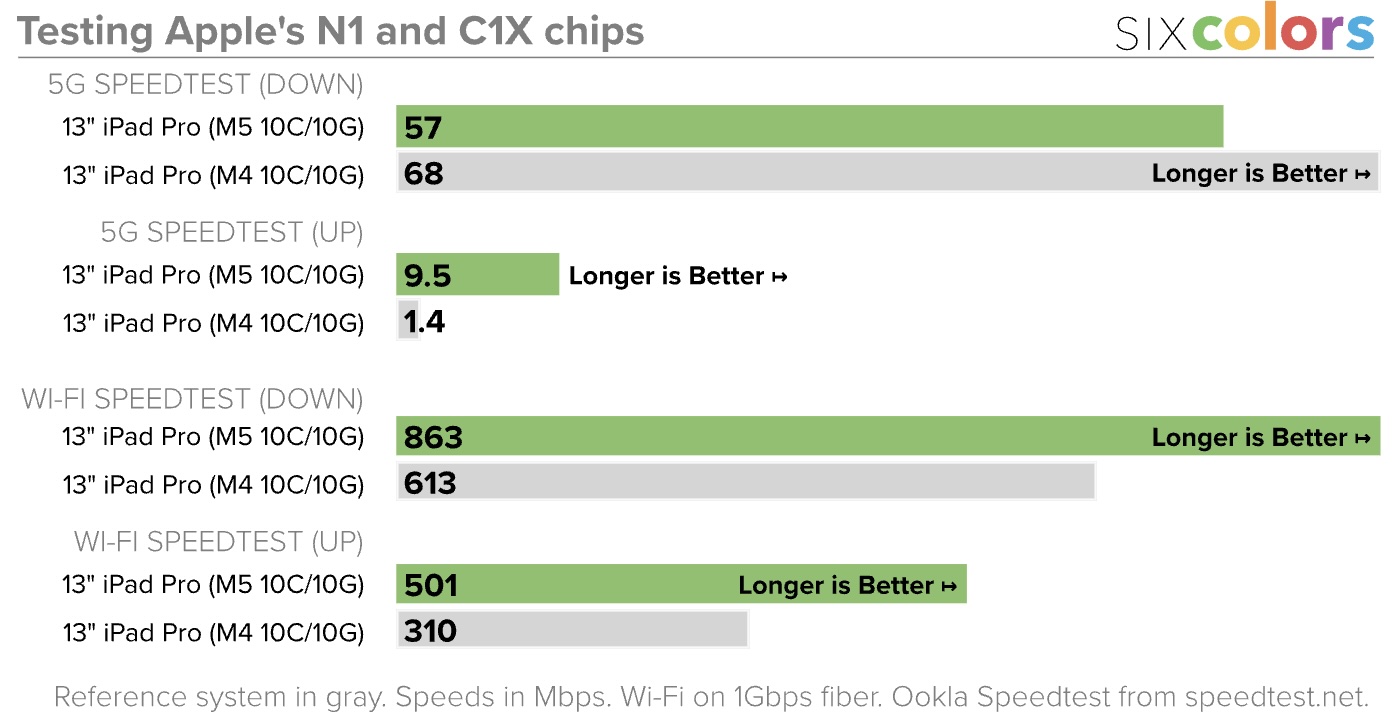
The new iPad Pro has up to a 15% to 20% faster CPU, and up to a 35% to 40% faster GPU, compared to the previous generation. Models with 256GB and 512GB of storage have a 9-core CPU, while 1TB and 2TB configurations have a full 10-core CPU.
The Verge‘s David Pierce on the M5 chip’s performance improvements:
If you’re coming from, say, an M1-powered iPad Pro, you’ll notice the performance improvement right away. Things that used to load and buffer now just render and save almost instantly. The leap from the M4, though, will only really appear if you’re moving huge amounts of video or 3D renderings through the machine. For all but the most aggressive, creative-professional workflows, the M4 was and is more than enough processor.
Here are six other upgrades beyond a faster processor:
- An increased 12GB of RAM for models with 256GB or 512GB of storage. 1TB and 2TB configurations still have 16GB of RAM.
- Apple’s custom N1 chip for Wi-Fi 7 and Bluetooth 6. However, the chip only supports up to 160 MHz channel bandwidth for Wi-Fi 7, short of the standard’s 320 MHz maximum. Apple says the chip also improves the overall performance and reliability of features like AirDrop and Personal Hotspot.
- Apple’s custom C1X chip for cellular configurations. With this modem, Apple says the new iPad Pro achieves up to 50% faster cellular data performance than its predecessor, and power efficiency is also improved.
- Apple says the new iPad Pro offers up to 2× faster SSD read and write speeds compared to the previous generation.
- The new iPad Pro can drive external displays at up to a 120Hz refresh rate, and Adaptive Sync is now supported, resulting in smoother scrolling and gameplay with lower latency on the external display.
- The new iPad Pro supports fast charging. Apple says up to a 50% charge can be reached in around 30 minutes for the 11-inch model, and in around 35 minutes for the 13-inch model. Apple has not shared similar figures for previous iPad Pro models, so it is unclear how much of an improvement this is.
Six Colors editor-in-chief Jason Snell said the N1 chip’s Wi-Fi 7 support resulted in faster Wi-Fi speeds compared to the previous iPad Pro with Wi-Fi 6E support.
As for the C1X chip, Snell said he saw slightly slower 5G download speeds on the AT&T network in the U.S., but significantly faster upload speeds:
I did my testing across two days on AT&T’s 5G network, and while speeds were all over the place, on average, the M5 iPad Pro was a little slower at download and a whole lot faster at upload. Obviously, your mileage will vary depending on your carrier and geography. It’s certainly a viable chip, and that 6.8× improvement in upstream speed was especially surprising.
The results of his N1 and C1X chip tests:
 Image Credit: Six Colors
Image Credit: Six ColorsMacStories editor-in-chief Federico Viticci on 120Hz support for external displays:
As soon as I connected the iPad Pro to my ASUS monitor, the resolution stayed at 4K, and the refresh rate was immediately bumped to 120Hz, resulting in faster and smoother animations out of the box with my existing USB4-certified cable. This is an excellent change; when I connect the M5 iPad Pro to my desk setup, I no longer have to sacrifice the quality of the iPad’s internal ProMotion display, and I can enjoy the same, smooth iPadOS animations on the ASUS monitor as well.
Viticci on fast charging:
I tested fast charging with this 160W UGreen power adapter and a 100W-certified USB4 cable, and I could indeed charge up to 50% in 30 minutes with the iPad’s display turned off on the Lock Screen.
While multiple reviews confirmed the new iPad Pro uses the latest PCIe 5.0 storage technology, we could not find any that tested SSD speeds.
Video Reviews
This article, “2025 iPad Pro Reviews: A Few Upgrades Beyond M5 Chip” first appeared on MacRumors.com
Discuss this article in our forums